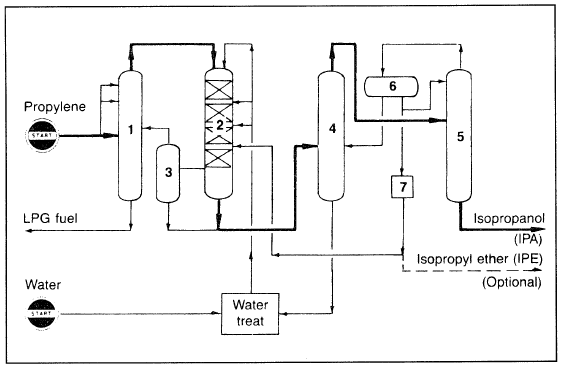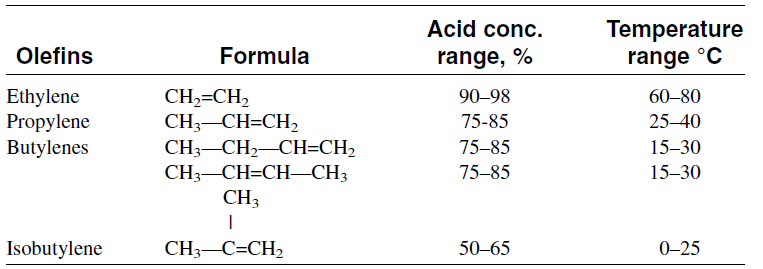
HYDRATION OF PROPYLENE (Isopropanol [CH3CHOHCH3])
 المؤلف:
sami matar & Lewis. F. Hatch
المؤلف:
sami matar & Lewis. F. Hatch
 المصدر:
Chemistry of PETROCHEMICAL PROCESSES
المصدر:
Chemistry of PETROCHEMICAL PROCESSES
 الجزء والصفحة:
p 227
الجزء والصفحة:
p 227
 31-8-2017
31-8-2017
 7035
7035
HYDRATION OF PROPYLENE (Isopropanol [CH3CHOHCH3])
Isopropanol (2-propanol) is an important alcohol of great synthetic utility. It is the second-largest volume alcohol after methanol (1998 U.S. production was approximately 1.5 billion pounds) and it was the 49th ranked chemical. Isopropanol under the name “isopropyl alcohol” was the first industrial chemical synthesized from a petroleum-derived olefin (1920).
The production of isopropanol from propylene occurs by either a direct hydration reaction (the newer method) or by the older sulfation reaction followed by hydrolysis. In the direct hydration method, the reaction could be effected either in a liquid or in a vapor-phase process. The slightly exothermic reaction evolves 51.5 KJ/mol.

In the liquid-phase process, high pressures in the range of 80–100 atmospheres are used. A sulfonated polystyrene cation exchange resin is the catalyst commonly used at about 150°C. An isopropanol yield of 93.5% can be realized at 75% propylene conversion. The only important byproduct is diisopropyl ether (about 5%). Figure 1.1 is a flow diagram of the propylene hydration process.
Gas phase hydration, on the other hand, is carried out at temperatures above 200°C and approximately 25 atmospheres. The ICI process employs WO3 on a silica carrier as catalyst.

Figure 1.1. A flow diagram for the hydration of propylene to isopropanol:16 (1) propylene recovery column, (2) reactor, (3) residual gas separation column, (4) aqueous - isopropanol azeotropic distillation column, (5) drying column, (6) isopropyl ether separator, (7) isopropyl ether extraction.
Older processes still use the sulfation route. The process is similar to that used for ethylene in the presence of H2SO4, but the selectivity is a little lower than the modern vapor-phase processes. The reaction conditions are milder than those used for ethylene. This manifests the greater ease with which an isopropyl carbocation (a secondary carbonium ion) is formed than a primary ethyl carbonium ion:

Table 1.1 compares sulfuric acid concentrations and the temperatures used for the sulfation of different light olefins
Table 1.1 : Acid concentration and temperatures used for the sulfation of various olefins

 الاكثر قراءة في البترو كيمياويات
الاكثر قراءة في البترو كيمياويات
 اخر الاخبار
اخر الاخبار
اخبار العتبة العباسية المقدسة


